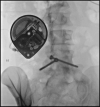Early Interventional Treatments for Patients with Cancer Pain: A Narrative Review
- PMID: 37223437
- PMCID: PMC10202202
- DOI: 10.2147/JPR.S405808
Early Interventional Treatments for Patients with Cancer Pain: A Narrative Review
Abstract
Between 10% and 20% of patients with cancer-related pain cannot achieve adequate control following the three-step ladder guidelines by the World Health Organization. Therefore, a "fourth step", including interventional approaches, has been suggested for those cases. Systematic reviews support the early use of interventional procedures to treat refractory cancer pain, control symptoms and prevent opioid dose escalation. There is strong evidence of the efficacy of celiac plexus or splanchnic neurolysis, vertebroplasty, kyphoplasty and intrathecal drug delivery. Those procedures have been found to be associated with a decrease in the symptom burden and opioid consumption, improved quality of life, and suggested as having a potentially positive impact on survival. Several studies have recommended using specific interventional techniques at earlier stages, possibly even when opioid treatment is first being considered. Conversely, leaving these options as a last analgesic resource might not be advisable since the burden these procedures might impose on too ill patients is significant. The objective of this review was to collect the available evidence published on the use of interventional treatments for refractory cancer pain with a particular interest in comparing early versus late indications. The results of the search demonstrated a very low number and quality of articles particularly addressing this question. This scarce number of evidence precluded performing a systematic analysis. A detailed and narrative description of the potential benefits of integrating interventional techniques into clinical guidelines at the early stages of the disease is provided.
Keywords: cancer pain; cement augmentation; early; interventional pain; intrathecal drug delivery; neurolysis; timing.
© 2023 Hochberg et al.
Conflict of interest statement
The authors report no conflicts of interest in this work.
Figures





Similar articles
-
Interventional Treatments of Cancer Pain.Anesthesiol Clin. 2016 Jun;34(2):317-39. doi: 10.1016/j.anclin.2016.01.004. Anesthesiol Clin. 2016. PMID: 27208713 Review.
-
Interventional pain management in cancer patients-a scoping review.Ann Palliat Med. 2023 Nov;12(6):1198-1214. doi: 10.21037/apm-23-433. Epub 2023 Oct 19. Ann Palliat Med. 2023. PMID: 37872129
-
Availability of and factors related to interventional procedures for refractory pain in patients with cancer: a nationwide survey.BMC Palliat Care. 2022 Sep 26;21(1):166. doi: 10.1186/s12904-022-01056-6. BMC Palliat Care. 2022. PMID: 36154936 Free PMC article.
-
Interventional pain treatments for cancer pain.Ann N Y Acad Sci. 2008 Sep;1138:299-328. doi: 10.1196/annals.1414.034. Ann N Y Acad Sci. 2008. PMID: 18837908 Review.
-
The future of Cochrane Neonatal.Early Hum Dev. 2020 Nov;150:105191. doi: 10.1016/j.earlhumdev.2020.105191. Epub 2020 Sep 12. Early Hum Dev. 2020. PMID: 33036834
Cited by
-
Management of pain in cancer patients - an update.Ecancermedicalscience. 2024 Dec 12;18:1821. doi: 10.3332/ecancer.2024.1821. eCollection 2024. Ecancermedicalscience. 2024. PMID: 40171458 Free PMC article.
-
Technical guideline for intra-prepontine cisternal drug delivery via spinal puncture through subarachnoid catheterization.Zhong Nan Da Xue Xue Bao Yi Xue Ban. 2024 Jan 28;49(1):1-10. doi: 10.11817/j.issn.1672-7347.2024.230597. Zhong Nan Da Xue Xue Bao Yi Xue Ban. 2024. PMID: 38615160 Free PMC article. Chinese, English.
-
Clinical observation of the treatment of refractory cancer pain with cancer pain information platform and IDDS under home analgesia mode: A retrospective study.Medicine (Baltimore). 2024 Jul 5;103(27):e38765. doi: 10.1097/MD.0000000000038765. Medicine (Baltimore). 2024. PMID: 38968525 Free PMC article.
-
Minimally invasive techniques versus opioids in patients with unresectable pancreatic cancer: a systematic review and meta-analysis of randomised controlled trials.Transl Gastroenterol Hepatol. 2025 Jul 9;10:45. doi: 10.21037/tgh-24-141. eCollection 2025. Transl Gastroenterol Hepatol. 2025. PMID: 40755737 Free PMC article.
-
Targeting TRPV4 Channels for Cancer Pain Relief.Cancers (Basel). 2024 Apr 27;16(9):1703. doi: 10.3390/cancers16091703. Cancers (Basel). 2024. PMID: 38730655 Free PMC article. Review.
References
Publication types
LinkOut - more resources
Full Text Sources
Medical

